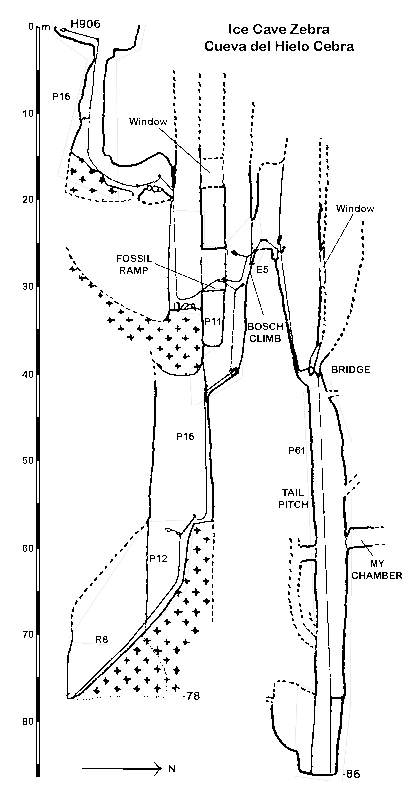Location Elevation Description How to Find Future Prospects Image Galleries
Cueva del Hielo Cebra (H906)
This cave was presumably noted in 1990 but was not explored until the following year when YUCPC descended this cave. Ice Cave Zebra is made up of a series of parallel interconnecting shafts, converging to give two routes: the more obvious (and extremely cold) route follows a glacial snow ramp, eventually choked at -78 m by ice; the second, attained by traversing and climbing a shaft chokes with rubble at -86 m. Through narrow tubes in the walls of this second main shaft, further shafts can be enticingly glimpsed. Quite an enjoyable cave.
Location X: Y: Z: m Depth -86 m
Surveys
Description
The cave contains a mixture of rawl bolts and spits.
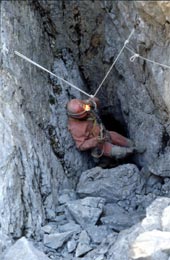
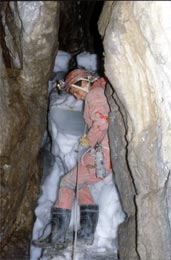 The Entrance Series
The Entrance Series
The entrance is along an obvious fault – extending in both directions for several hundred yards. The fault breccias appears to be made of very hard crystaline carbonates. The original development was along either side of the fault. The surface rift gradually descends to the entrance shaft proper. This is rigged with a long traverse and backup line to a Y-hang across the rift. A pitch of 14 m with a deviation 9 m down arrives on snow.
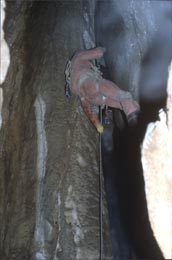
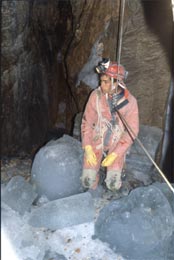 Walk down using hand line to a psychological thread on the left, by the hole.
Then climb up over the hole to a rubble slope over a huge rocking boulder to a
hand line down the other side of choss to head of second pitch.
Across the shaft a window leads above the ramp. Drop 9 m to the snow plug below, from
where the short climb opposite gains a fossil ramp. This ramp is obviously
part of a much older system originally from an entrance to the north but
intercepted by the younger series of shafts. From here the ways diverge.
Walk down using hand line to a psychological thread on the left, by the hole.
Then climb up over the hole to a rubble slope over a huge rocking boulder to a
hand line down the other side of choss to head of second pitch.
Across the shaft a window leads above the ramp. Drop 9 m to the snow plug below, from
where the short climb opposite gains a fossil ramp. This ramp is obviously
part of a much older system originally from an entrance to the north but
intercepted by the younger series of shafts. From here the ways diverge.
The Snow Route
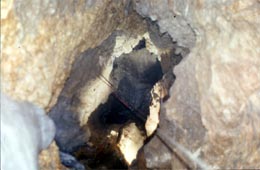 A pitch of 9 m via a distant deviation is followed by a
A pitch of 9 m via a distant deviation is followed by a
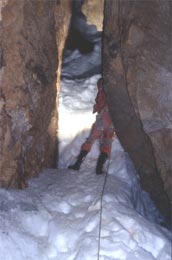 steeply descending ice slope (care) requiring a hand line to a rebelay. Descend 4 m to a deviation,
followed by a further 15 m taking care to avoid the snow and ice dropping
from the snow plug above. Having landed on a snow and ice ledge, walk over to
the right to the next bolt, using the pitch rope for protection.
steeply descending ice slope (care) requiring a hand line to a rebelay. Descend 4 m to a deviation,
followed by a further 15 m taking care to avoid the snow and ice dropping
from the snow plug above. Having landed on a snow and ice ledge, walk over to
the right to the next bolt, using the pitch rope for protection.
Descend between rock and snow plug at about 60º, past a deviation round a `really strong' icicle, down the remainder of the snow ramp – which curves around to the right – using the rope near the bottom as a hand line.
Tail Pitch
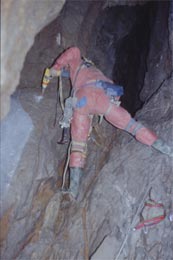 The other way on from the ramp involves climbing to the obvious fossil window
5 m up over the third pitch. Several rawl bolts are in place and with
additional protection from naturals it is quite easy. At the top of
Bosch
Climb the rift joins with
Tail Pitch. A Y-hang from a thread and
bolt gives a drop of 15 m to a bridge and Y-hang
― mark II! The final descent is a pitch of 45 m via several deviations
(care – loose walls). The base ends in choss – mainly from gardening of the shaft
walls and rigging failures. No draught was noticeable amongst the choss.
The other way on from the ramp involves climbing to the obvious fossil window
5 m up over the third pitch. Several rawl bolts are in place and with
additional protection from naturals it is quite easy. At the top of
Bosch
Climb the rift joins with
Tail Pitch. A Y-hang from a thread and
bolt gives a drop of 15 m to a bridge and Y-hang
― mark II! The final descent is a pitch of 45 m via several deviations
(care – loose walls). The base ends in choss – mainly from gardening of the shaft
walls and rigging failures. No draught was noticeable amongst the choss.
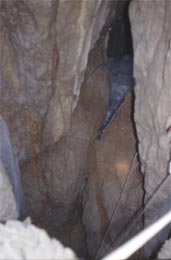 Tail Pitch has rather complex features. From the top, another shaft can be
seen through a window in the opposite wall. This shaft reappears at the
bridge. To the eastern side at the bridge a short rift ends in a 4 m descent
to a ledge rejoining the main shaft. A phreatic from the ledge leads to
`space' behind the wall – unfortunately we
didn't have a Jack Russel to shove through. This `space' is suspected to be
part of a shaft joining 14 m below the bridge. Just below the bridge – on the western side – a very small crack leads to another
shaft – inaccessible.
Tail Pitch has rather complex features. From the top, another shaft can be
seen through a window in the opposite wall. This shaft reappears at the
bridge. To the eastern side at the bridge a short rift ends in a 4 m descent
to a ledge rejoining the main shaft. A phreatic from the ledge leads to
`space' behind the wall – unfortunately we
didn't have a Jack Russel to shove through. This `space' is suspected to be
part of a shaft joining 14 m below the bridge. Just below the bridge – on the western side – a very small crack leads to another
shaft – inaccessible.
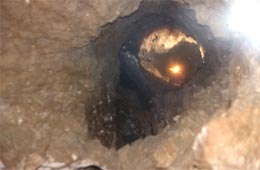 At about 20 m below the bridge, two tubes lead off from the shaft. The higher
one, `My Chamber', is a 3 m rift. The phreatic upper section continues
and a void can be seen beyond, but the rift is only 8 cm wide. On the opposite
side another tube leads off directly to an un-descended shaft. This oxbows
back into the main shaft – together with another shaft.
At about 20 m below the bridge, two tubes lead off from the shaft. The higher
one, `My Chamber', is a 3 m rift. The phreatic upper section continues
and a void can be seen beyond, but the rift is only 8 cm wide. On the opposite
side another tube leads off directly to an un-descended shaft. This oxbows
back into the main shaft – together with another shaft.
How to Find
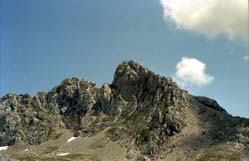 Walk along the path from Vega Huerta along the path as if to the
Canal de Perro. At
the first grassy col, descend down the first major gully on the left towards the
base of the large doline with three stone circles. At the circles, keep to the
left following the goat tracks (contours), curving round to the right at the end
of the depression and climbing over between the col. From here an obvious path
can be followed up valley in an easterly direction to a `pass' with many choked
shake holes. On the right can be seen a fault. The entrance lies 20 m from the
path along this.
Walk along the path from Vega Huerta along the path as if to the
Canal de Perro. At
the first grassy col, descend down the first major gully on the left towards the
base of the large doline with three stone circles. At the circles, keep to the
left following the goat tracks (contours), curving round to the right at the end
of the depression and climbing over between the col. From here an obvious path
can be followed up valley in an easterly direction to a `pass' with many choked
shake holes. On the right can be seen a fault. The entrance lies 20 m from the
path along this.
Future Prospects
The potential for this cave seems good – possibly in a year following several very wet Summers and little snow fall. The ice plugs are however probably quite old – as there is no direct entrance for the snow. As discussed in the description of Tail Pitch, there is the possibility of gaining access to further parallel shafts – maybe from the surface.
Another rubble filled entrance from an adjacent shake hole probably leads into the second shaft. Along and around the fault are many more impassable shake holes.


